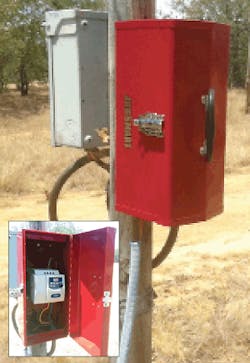Illustrated Code Catastrophes: Table 110.28 and Section 440.6
Has Anyone Seen My New Tool Box?
“We found this pole-mounted ‘tool box’ on an oil lease property,” says James Bishop, president, Bishop Electric, Duncan, Okla.
This isn’t the first time I’ve seen someone use a tool box to try and protect electrical equipment. But does anyone else find it ironic that this tool box is branded with a “JOBSMART” label?
The 2011 NEC defines a cabinet as “an enclosure that is designed for either surface mounting or flush mounting and is provided with a frame, mat, or trim in which a swinging door or doors are or can be hung.” It defines an enclosure as, “the case or housing of apparatus, or the fence or walls surrounding an installation to prevent personnel from accidentally contacting energized parts or to protect the equipment from physical damage.” Table 110.28 lists the various types of enclosures and type numbers suitable for outdoor use.
A tool box is simply not listed for use as an electrical cabinet or enclosure.
How Many Violations Can You Spot on This Shopping Spree?
“My brother found this while servicing an air conditioner at a local shopping mall,” says Ken Stefura, a building maintenance engineer with ABM in Hopatcong, N.J. “You’d think the installer would have noticed the feeder sizes on the 50A breaker were a little smaller than the one above.”
Although it’s a little difficult to see in these photos, it does appear the conductors for A/C 1 are smaller than those serving A/C 2. The ampacity of conductors and equipment rating requirements for A/C and refrigerating equipment are noted in 440.6 of the 2011 NEC.
In addition, the use of all-white wires from the panelboard to the fused disconnect is a violation of the identification requirements noted in 210.5(C), 215.12(C), and 310.110(C). A wire with a white outer finish is used to designate a grounded conductor (see requirements in Art. 200). Color-coding requirements for grounded conductors are shown in 200.6 and 200.7.
About the Author
Joe Tedesco
Tedesco served the industry in many roles during his career. He was a director, senior electrical code instructor for National Technology Transfer, Inc. and American Trainco, Inc.. He was also a codes, standards and seminar specialist for the International Association of Electrical Inspectors and an electrical field service specialist for the National Fire Protection Association in Quincy, Mass. He ran his own business as an NEC consultant and is a Massachusetts licensed master electrician and journeyman electrician and certified electrical inspector (one and two family 2A; General 2B, and Plan Review, 2C). Tedesco also wrote articles for CEE News and EC&M (Code Violations Illustrated and What's Wrong Here?) for more than 15 years and helped launched the Moving Violations video series.
